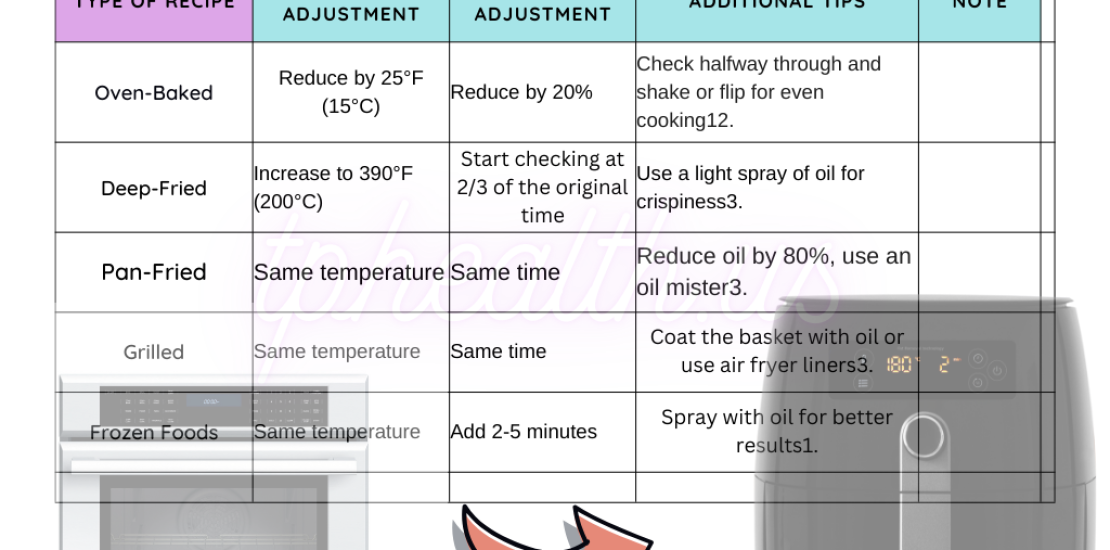Air fryers have revolutionized the way we cook by offering a healthier alternative to traditional frying. With this amazing kitchen gadget, you can prepare your favorite dishes using significantly less oil, but what if you want to convert your old favorite recipes to air fryer-friendly ones? Don’t worry—this article will guide you through the entire process, ensuring that your culinary creations turn out delicious every time.
Why Convert Recipes to Air Fryer?
If you’ve recently purchased an air fryer, you may wonder why you should bother converting your traditional recipes. The main reason is simple: air fryers provide a healthier cooking option without sacrificing flavor. They use hot air to crisp and cook food, cutting down on oil without compromising that golden-brown texture we all love. Additionally, air fryers are quicker, cleaner, and far more convenient than your oven or stovetop, making them perfect for busy households.
Understanding the Basics of Air Frying
Before diving into conversion techniques, let’s understand the basics of how air frying works. The air fryer circulates hot air around the food at high speeds, cooking it quickly and evenly. It’s like a mini convection oven that not only cooks faster but also achieves crispiness similar to deep frying. Unlike a traditional oven that radiates heat from a single source, the air fryer ensures that every side of your food is exposed to hot air, making it perfect for achieving that crispy texture with minimal oil.
Temperature and Time Adjustments
One of the biggest hurdles in converting recipes is adjusting cooking time and temperature. When converting oven-baked recipes to the air fryer, you typically need to reduce the cooking temperature by 25°F to 30°F and cut the cooking time by about 20%.
For instance, if a recipe calls for baking at 400°F for 30 minutes in an oven, set your air fryer to 375°F and cook for about 24 minutes. However, always check on your food about halfway through to ensure you’re getting the desired result.
Using a food thermometer is also crucial to ensure that proteins like chicken or pork are cooked to the correct internal temperature, which maintains food safety while keeping it tender and juicy.
Reducing the Amount of Oil
Traditional frying recipes often require submerging food in oil. Fortunately, air fryers only need a light spray of oil to achieve similar results. When converting recipes, remember to cut down on the oil drastically. Instead of using a cup of oil, a few sprays of oil from a spray bottle will suffice.
Foods like French fries, chicken wings, or breaded items need just a light coating of oil to crisp up perfectly in an air fryer. This small change will help cut calories and fat from your meals without losing the crunchiness you love.
Modifying Baking Recipes
Yes, you can bake in your air fryer! But baking in an air fryer requires a few tweaks compared to a conventional oven. First, use smaller portions of dough or batter since the compact size of the air fryer basket won’t accommodate large baking pans.
Silicone molds or small cake tins are perfect for air fryers. If you’re making cookies, cakes, or muffins, consider cutting the recipe in half and baking in smaller batches. Make sure to reduce the baking time by about 20%, just like you would with other dishes, and always check your baked goods with a toothpick for doneness.
How to Air Fry Vegetables
Air frying vegetables is a breeze, but there are a few tricks to get them just right. Vegetables like broccoli, Brussels sprouts, or bell peppers cook beautifully in the air fryer, getting tender on the inside and slightly crispy on the outside.
To convert a traditional roasted vegetable recipe, reduce the oil and toss your veggies in just a small amount of seasoning and oil before placing them in the basket. Cook at a temperature of around 350°F to 375°F for 10-15 minutes, shaking the basket halfway through for even cooking.
For starchy vegetables like potatoes or sweet potatoes, a slightly higher temperature of 400°F might be needed for that perfect, crispy finish.
Converting Meat Dishes to Air Fryer
Meat dishes like fried chicken, pork chops, or fish are often the highlight of a meal. The air fryer can handle these recipes easily, but you’ll need to adjust a few things for the best results. First, if the recipe calls for frying in oil, reduce it to just a light spritz of oil on each side of the meat.
For meat dishes, lower the cooking temperature by about 25°F to prevent overcooking and drying out. Always check the internal temperature with a meat thermometer. Chicken thighs, for example, should reach 165°F internally, while steaks or pork chops need to hit 145°F.
Cooking Frozen Foods in an Air Fryer
Frozen foods like chicken nuggets, French fries, or even frozen vegetables can be cooked directly in the air fryer without thawing. This makes the air fryer a great tool for quick and convenient meals.
When cooking frozen foods, you may not need any oil at all, but it’s important to shake the basket halfway through to ensure everything cooks evenly. Most frozen foods will cook faster in an air fryer, so check on them regularly to avoid overcooking.
Avoiding Common Air Fryer Mistakes
Converting recipes is fun, but there are a few common mistakes to avoid. Overcrowding the air fryer basket is one of them—this can result in uneven cooking, so make sure there’s enough space for the hot air to circulate.
Another mistake is not preheating the air fryer. Preheating helps the air fryer reach the correct temperature faster, which leads to better cooking results. Lastly, always monitor your food and flip or shake the basket halfway through to ensure even cooking.
Maintaining Texture and Crispiness
One of the key benefits of air frying is achieving that perfect crispy texture, but how do you maintain it? The trick is to avoid using too much oil, overcrowding the basket, and not flipping the food.
If you’re cooking breaded items like chicken tenders or mozzarella sticks, spritz the breading with a little oil to help it crisp up evenly. Cook at a high temperature of around 400°F and serve immediately for the best results. Leftovers may lose their crispiness, but you can reheat them in the air fryer to regain some crunch.
Adapting Casserole and One-Pan Dishes
Casseroles and one-pan dishes may seem challenging to convert to an air fryer, but it’s possible with the right adjustments. You may need to cook the ingredients separately and then combine them at the end.
For example, if you’re making a chicken and vegetable casserole, air fry the chicken first, then cook the vegetables, and finally combine everything for a few minutes in the air fryer. You can use small, air fryer-friendly pans for layering ingredients and baking them into a casserole-style dish.
How to Clean Your Air Fryer
Cleaning your air fryer properly is essential for maintaining its longevity and performance. After every use, make sure to clean the basket, tray, and other removable parts with warm soapy water. Most air fryer parts are dishwasher safe, making cleanup easy.
Wipe down the inside of the air fryer with a damp cloth and be sure to remove any food residue that may have accumulated. Regular cleaning will also prevent unpleasant odors and ensure your air fryer is always ready for use.
Health Benefits of Air Frying
One of the most significant advantages of air frying is its health benefits. Since air fryers use significantly less oil, the fat and calorie content of your meals is drastically reduced.
Compared to traditional frying methods, air frying lowers your intake of unhealthy trans fats and keeps cholesterol levels in check. This makes it an excellent option for people looking to adopt a healthier lifestyle without giving up their favorite fried foods.
Conclusion
Converting your traditional recipes to air fryer-friendly ones opens up a world of possibilities in the kitchen. Whether you’re cutting down on oil or just looking for quicker and easier cooking methods, the air fryer can handle it all. With these tips, you can confidently adapt your favorite dishes and enjoy crispy, delicious results every

